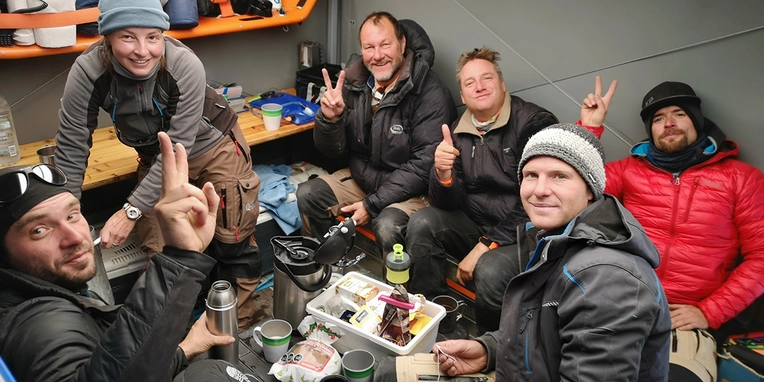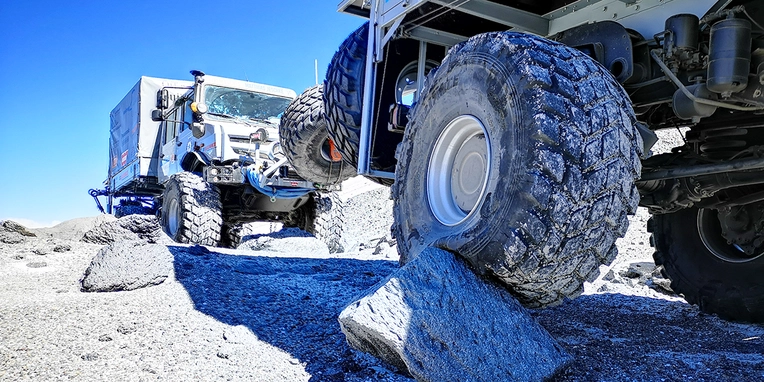Special ALLIANCE tyres.
For this purpose, first of all AS Söder from Wildflecken equipped the U 5023 with a special body for variable centre-of-gravity balancing and a powerful winch. In order for the vehicle to be able to make its way through the roughest stone and rock formations larger tyres were needed. ALLIANCE produced hand-made tyres designed to overcome every resistance and withstand temperatures from -30 to +40 °C.
The chain – a hand-crafted prototype.
Together with engineers from the Unimog plant in Wörth, Daniel Müller took charge of the remaining tasks. These included relocating the tail lights and compressed air reservoirs as well as the fuel tank so that the record-seeking vehicle would be able to use large chains. "At night the sand freezes and during the day the sun beats down on the mountainside. That’s why we needed great claws to dig through the thawed-out sand and grip the frozen ground beneath," continues the workshop manager.
Andreas Stahlhofer, qualified engineer and Daniel Müller’s tent companion during the expedition, had designed the chain himself and welded it together in meticulous month-long piecemeal work in his own garage.
Doubly raised height and suspension adaptation.
The finger-thick chains, adding up to 10 cm to the wheel radius, naturally affected the suspension. "The vehicle body was already raised by Mercedes," continues Daniel Müller. "On account of the large tyres and the specially-constructed chain we doubled the height adaptation." However, this task was far from simple, since the raised chassis meant the cross struts, shock absorbers and ALB control (automatic load-dependent brake force regulator) on the rear axle had to be adjusted, too. The advantage of greater height: the higher and more offroad-capable a vehicle is, the less need to remove any obstacles by hand.
The steering movement was also a challenge: "Normally the steering radius of the wheels is very limited on the Unimog," explains the man from Gaggenau. "It takes really a lot of technical know-how to make these big wheels turn in." To make this possible the front bumper was re-worked and placed a little further forward, a different hydraulic oil reservoir was installed and the steps behind the front axle were modified.
Unimog sets world altitude record in Chile
Specially-programmed tyre pressure control system.
In addition, the traction of the expedition-ready 8.5 t vehicle on rugged terrain had to be ensured. To this end, the tyre pressure control system was subjected to a special programming to allow the tyre pressure to be reduced down to 0.1 bar. "Under normal conditions, 1–1.2 bar is the limit," says Daniel Müller. Apart from this, the tyres were glued to the rim so that they wouldn’t come off the rim at such a low tyre pressure.
The core remains the same.
On the other hand, the heart of the vehicle was left unchanged. Powered by a centrally-placed engine which in the current U 5023 is located behind the front axle, and by the Unimog UG 100 hydraulic clutch and auxiliary transmission, the two "universal motorised machines" set out to tackle the highest summit in Chile.
The Unimog: rescuer in the direst need.
In December 2019 it was now the task of Jeschke’s team to equip dedicated high-altitude refuges with emergency radio units for mountaineers with the help of the two highly offroad-capable Unimog trucks. "In the first night in which the radio system was put into operation, we were already able to save a life," recounts Daniel Müller. "Night was falling and all we wanted to do was go to bed. But then some distraught mountaineers came to us, saying that one of their group was missing."
Two Canadian brothers had become separated while coming down from the summit. One of the brothers had gone ahead and had arrived in their camp. The other one had not made it back. "We radioed the emergency unit in the refuge from the Unimog. That way we knew when the other brother had passed this last high-altitude station and were thus able to work out approximately where he would have to be."
He was eventually found crying behind a rock. He had taken off his jacket and had lost his rucksack. Without the rescue operation – which was only made possible by the Unimog – the mountaineer would have frozen to death in the night. "That is a very emotional experience and in a night like that you no longer sleep at all," observes the workshop manager.
Breathless at freezing heights.
A problem that must be taken very seriously at altitudes of 6000–7000 m is the extremely thin air: "The plan was for our team to consist of almost twenty members," continues Daniel Müller. However, many did not make it this far due to high altitude sickness. But the vehicles, too, felt the lack of oxygen at these freezing great heights. "You only have about half the normal output up there," explains the workshop manager. "And that with over eight tonnes." That’s formidable and as a result you must ensure that everything works really well. Of the team, which eventually consisted of ten persons, only five reached the highest point. "All of them were participants in the base team we ourselves put together," the man from Gaggenau is proud to affirm.
In the end there was a double world record.
In the end, it was not possible to reach the very summit with the Unimog due to glaciers. Having reached an altitude of 6694 m, Daniel Müller’s and Matthias Jeschke’s expedition team did set a double world record, though. In addition to the altitude record for wheeled vehicles, never before had a high-altitude expedition taken two trucks at the same time to such heights anywhere in the world. Two is indeed better than one. That goes for the Unimog U 5023, too.



















